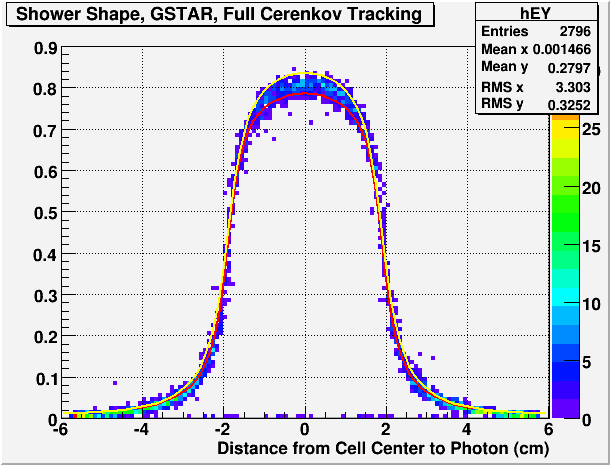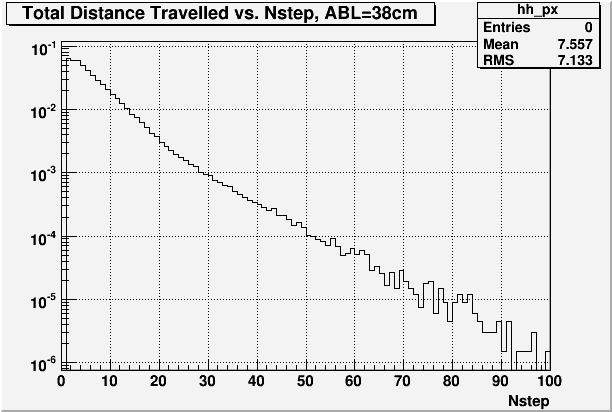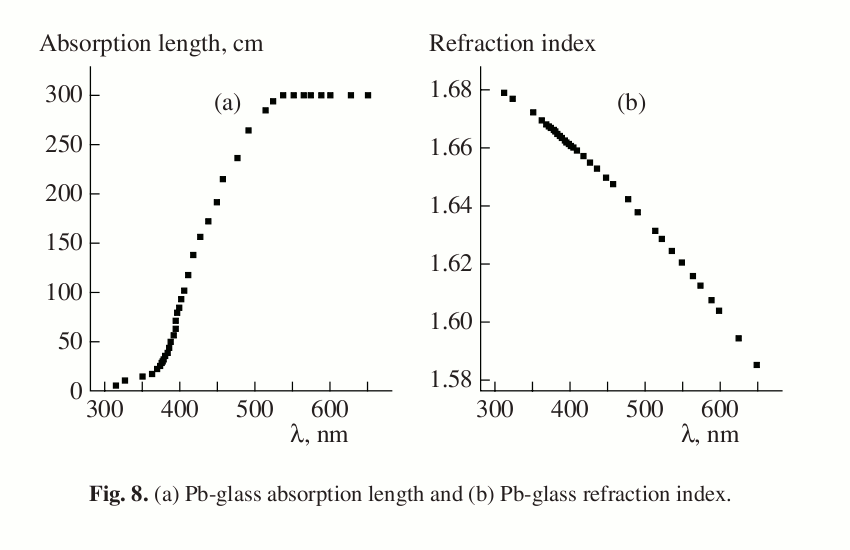Shower Shape Based on Cerenkov Photon
Shower Shape Based on Cerenkov Photons
As shown by Steve in this document, we can get a shower shape that is substantially narrower than what we normally get from GSTAR by collecting Cerenkov photons. (with some cut on the angle at which they were generated) This shape resembles the data much better than the normal shower shape based on energy loss.
My goal then was to repeat/confirm in GSTAR what Steve sees in his stand alone Geant 4 compilation. The first thing I did was to turn on the Cerenkov option which had been previously disabled. I've found that this increases the CPU time by two orders of magnitude. Nevertheless, I was able to run enough events to get the shower shape.
Fig. 1. FPD Photon Shower Shape from GSTAR based on full tracking of Cerenkov Photons.

Also shown in red is the previous fit on GSTAR based on energy loss, and in yellow is the fit on data.
Clearly, the new shape splits the difference between data and simulation, failing to reach the narrowness of the data. Compared to Steve's result, it is much wider still.
In order to understand the difference between my results and the data and/or Steve's results, it was necessary for me to get a little deeper into GSTAR to check/modify the tracking process of optical photons. (We probably had to do this anyway if we wanted to avoid full tracking of the optical photons eventually) This at least for me was not a trivial task, and I've documented the recipe to add a user routine to the GSTAR steps in this page.
In Geant, particle tracking is done by number of separate modules based on the particle type. Optical photons generated by Cerenkov radiation is handled completely differently from regular photons, receiving their own particle code. (IPART=50 versus 1 for the normal photons) The module that tracks optical photons is called GTCKOV. Normal photons are tracked by GTGAMA.
After staring at the print outs of the optical photon tracking, I realized that way too many of them seemed to get absorbed before they reach the photo cathode.
Fig. 2. Distance traveled vs. Number of steps for Cerenkov photons before they get absorbed in Pg glass

By looking at the print outs, it's clear that one step in the tracking of an optical photon (at least for the FPD) corresponds to a reflection at the cell boundary. I'm not sure if the minimum step size seen here is related to that, or a hard minimum defined somewhere.
Fig. 3. Fraction of the generated Cerenkov photons as a function of the distance traveled before they get absorbed in Pb glass.

We see that ~40% of the generated photons are gone within the Pb glass before they travel 40cm. This seems extreme, as the Pb glass has a length of 45cm, and something like 40% loss in photon count should be noticeable just by looking at them. Turns out, there is a line in the geometry file that I've never paied attention to that sets the absorption length of the Pb glass to 38cm for all energy. This could easily widen the shower shape, as the part that's generated in the front of the glass is narrower than the part generated near the cathode.
So I've looked up the NET paper by Les and others on our Pb glass cells, and found the following plots. ("An electromagnetic shower profile in the lead glass calorimeter in the energy range of 3-23 GeV")
Fig. 4. Absorption length and refraction index of the Russian Pb glass cells from this paper

Since I don't have the exact number for each point, I simply read the value off the left-hand side plot for each of the 12 energy bins defined in the geometry file and used them.
Fig. 5. Distance traveled before absorption for the default absorption length of 38cm vs. using the values from the paper.

This seems to increase the number of photons hitting the photo cathode by roughly a factor of 2. The resulting shower shape looks like the following.
Fig. 6. Shower shape using the energy dependent absorption length taken from the above mentioned paper.

Also shown in red is the previous fit on GSTAR based on energy loss, and in yellow is the fit on data.
So it seems that doing the full Cerenkov + using more sensible absorption length produces a shower shape that is very close to that of the data.
The next thing to do is to figure out how to get something very similar without burning as much CPU time. I've tried putting random numbers into the hit routine, and only tracking a small fraction of the photons. Considering that the total number of Cerenkov photons for a 40GeV photon is close to 2.5M, this should really work just fine. But so far I see that the effect of fractional reduction introduces unreasonable amount of fluctuation in the number of photons that survive the cut.
- leun's blog
- Login or register to post comments
